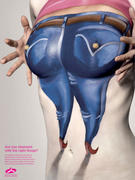Since the beginning of time, humans have always had the desire to create art. Through this desire body painting was born, making the human body the first canvass. The history of this craft stretches so far back that historians consider it to be the earliest form of art. Compared to other types of body art like tattoos or piercing, this is impermanent. It lasts only for a few hours at most.
During the ancient times, tribes would often use this during celebrations and important ceremonies. Each color had its own corresponding meaning. Chieftains and warriors commonly had their own styles to indicate their status in the tribe. Around the 12th century, a new kind of body painting known as the Mehendi became popular. The Mehendi is an extremely old ritual that originated from Egypt. It is the art of using henna to paint the body. This type of dye usually lasts a little longer, about a 1-2 weeks before fading. Natives of South America also had their own methods of ornamenting their bodies. They would use wet charcoal also known as huito. Like henna, huito is also semi-permanent lasting for a few weeks.
In today's modern era, this has become a way of self-expression. This has been spurred on by the liberality of modern society. If before nudity was deemed by society as inappropriate and improper, now it is something to be flaunted. In the guise of self-expression and the practice of human freedom, this has become a means of grabbing the public's attention. This is especially effective during protests and rallies. Instead of bringing placards and sign boards, the protesters would instead paint on themselves.
The art of body painting can morph a human being into a beautiful work of art. It can make a statement that words alone cannot express, create a more appealing presentation, and add meaning and significance to an important occasion. It is used not only for the living, but also to preserve the dead. Truly it has attained world wide significance that will last till the end of time.
 Face painting is an art that is both fun and easy to do. Your canvass here is the human face. This is only temporary and lasts for a few hours at most. Traditional body painting started in the early 12th century. In some cultures, this was done for religious rituals; in others, to celebrate ancient ceremonies. Today, it is done more for fun.
Face painting is an art that is both fun and easy to do. Your canvass here is the human face. This is only temporary and lasts for a few hours at most. Traditional body painting started in the early 12th century. In some cultures, this was done for religious rituals; in others, to celebrate ancient ceremonies. Today, it is done more for fun. If you are new to the art of body face painting, here are some rules you should keep in mind.
If you are new to the art of body face painting, here are some rules you should keep in mind.























